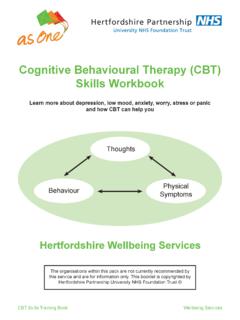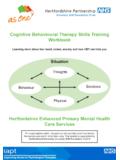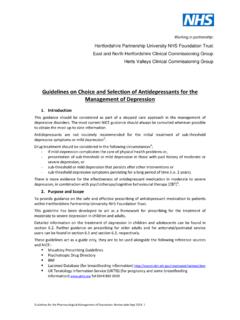Transcription of Physical Health Strategy 2017-2022 - Hertfordshire …
1 1 Great Care, Great Outcomes Physical Health Strategy 2017-2022 2 Table of Contents Being Bothered About Billy .. 3 Executive Summary .. 4 1. 2. National Policy and Causes of poor Physical Physical Health issues by demographic Older People .. 7 Children and Adolescents .. 7 Learning Disabilities .. 7 Carers .. 7 3. Local 8 Sustainability and Transformation Plans (STP) .. 8 Local Mental Health Strategies .. 8 Good to Great Strategy .. 8 HCT Alliance .. 9 Having Your Say Survey Results .. 9 4. Approach to developing the Strategy .. 9 Building on Progress.
2 9 Coproduction .. 10 Service User and Carer Feedback .. 10 5. Our 6. Key Priorities .. 11 7. Key Enablers of the Strategy .. 12 8. Implementation, monitoring and assurance .. 144 9. Conclusion .. 14 Appendix I: Year One Delivery Plan 2017/18 .. Appendix II: Communications and Engagement Plan .. 3 Let me introduce you to Billy. Billy is your brother, your colleague, your son, your friend, your father. He also uses our services. At 39, he has a 21 year history of Schizophrenia. He is obese with a BMI of He smokes 20 cigarettes a day, but drinks very little alcohol. He is on blood pressure tablets as he suffers from hypertension.
3 The antipsychotics that Billy takes have significantly contributed to his weight gain and development of Type II Diabetes - two risk factors which are highly correlated with each other. Billy s risk of having a heart attack or stroke within the next 10 years is 33%, (compared to just in the general population). This means he currently stands to lose 15-20 years of his life.. If Billy had received early interventions He could be an ex-smoker His weight gain may never have occurred As a consequence, he may not have been diagnosed with type II diabetes His 10 year risk of a heart attack or stroke would be , instead of 33% It boils down, quite simply, to being bothered about Billy - Professor Helen Lester Weight loss: If he lost 5kg: If he lost 15kg: 29% If he had a BMI of : Smoking cessation: If he smoked 10-19/day: If he was an ex-smoker: If he had never smoked.
4 Early Screening and intervention for Type II Diabetes: Without Diabetes, Billy s risk of cardiovascular disease would fall from 33% to How can we support Billy? Being Bothered About Billy 4 Executive Summary Overview This Physical healthcare Strategy has been developed to support delivery of the ambitions outlined in the Trust s Good to Great Strategy . It aligns with our mission to help people of all ages live their lives to their full potential by supporting them to keep mentally and physically well . Background This Strategy recognises that to provide great care and achieve great outcomes the Physical Health of our service users and their carers must be supported.
5 This needs to start from birth and be continued through to end of life, regardless of diagnosis. The Physical Health of people with severe mental illness (SMI) is known to be significantly worse than that of the general population; these individuals on average die 15-20 years prematurely. The vast majority of these premature deaths are not due to suicide, but instead are caused by chronic medical conditions as a result of a number of modifiable risk factors, including tobacco and alcohol consumption, poor diet, and lack of Physical activity. By effectively addressing known modifiable risk factors, the Physical Health outcomes of service users can be significantly improved.
6 The disparity in life expectancy and Physical Health outcomes between people with mental Health disorders and the general population also has the potential to be considerably reduced. Aims This Strategy identifies a number of overarching aims: To ensure our service users are supported to achieve the best possible Physical Health status, in addition to providing excellent mental Health care and support. To achieve year on year improvement across a range of Physical indicators for our service users ( smoking, obesity, alcohol consumption) To ensure our service users receive appropriate support to address their Health -risk behaviours.
7 To ensure that staff are confident in their knowledge and skills to support service users in achieving their best possible Physical Health outcomes. To work in collaboration with partner organisations to achieve better Physical and mental Health outcomes for the population. 5 1. Introduction This Physical healthcare Strategy has been developed to support delivery of the ambitions outlined in our Good to Great Strategy . It aligns with our mission to help people of all ages live their lives to their full potential by supporting them to keep mentally and physically well . Figure 1 below is taken from the Good to Great Strategy .
8 The development of our workforce, working in partnership with others and the development of systems and processes have been identified as critical to the successful delivery of this Strategy . Figure 1 Good to Great Strategy The disparity in Physical Health outcomes between people with mental Health problems and the general population is stark, and can significantly impact on their quality of life, and life expectancy. People with SMI on average die 15-20 years earlier than the general population. The vast majority of these premature deaths are not due to suicide, but instead are caused by chronic medical conditions such as cardiovascular, respiratory and infectious diseases, diabetes and hypertension.
9 We can make a difference with many of these conditions. In adopting a fresh mind-set as an organisation and as individual practitioners, we have the opportunity to substantially improve the Physical Health of our services users and carers; we can support them to improve the quality of their lives and will ultimately be able to reduce the difference in life expectancy between people with SMI and the general population. 6 Furthermore, addressing aspects of Physical Health can have a profoundly positive impact on a person s mental Health . Ultimately, this Strategy is concerned with us becoming more bothered about Billy.
10 2. National Context Policy and Guidance Over the last few years national policies and guidance, including the Five Year Forward View for Mental Health , have placed increasing emphasis on the need to support people with their Physical and mental Health needs rather than seeing the two in isolation. Indeed a fundamental feature of the Five Year Forward View for Mental Health is that people s mental Health needs should be treated with equal importance as their Physical Health needs, whatever NHS service they are using. The Kings Fund published a paper in 2016 entitled Bringing Together Physical and Mental Health which provides compelling evidence of the importance of integrated care, and highlights a number of high impact areas that could be made to improve quality of care and outcomes.














